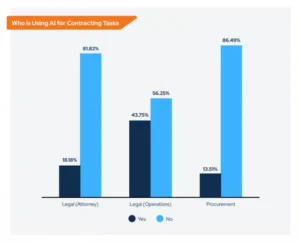
The state of AI and contracting: A 2023 snapshot of its usage and potential
If there is one message for tech buyers as we approach 2024, it is that AI is here – ready or not.

If there is one message for tech buyers as we approach 2024, it is that AI is here – ready or not.
That said, it’s important that professionals in all industries consider the potential uses of artificial intelligence, especially when it comes to their contracting.
After all, more than 26% of the business organization is involved in contracting one way or another. With such a significant business function, it’s no wonder that contracting has begun an AI transformation, bringing with it capabilities ranging from searching contracts to importing data from legacy systems.
But just how widespread is the use of AI in contracting? Who’s using it – and for what? And how high is the demand among those who have not yet taken the AI plunge?
Agiloft recently set out to answer these questions and more with “The State of the Market: AI Usage and Intent in the Legal Industry,” which surveyed legal and procurement professionals around the world.
Read on for key highlights from the report.
How many contracting professionals are using AI, and for what?
AI’s rapid emergence into the business world can be directly traced to the debut of ChatGPT in November 2022. The technology’s ability to scan and summarize large amounts of text quickly and form creative outputs from prompts has been a game changer for many industries, even in its nascent stage.
That said, AI is not just futuristic, aspirational technology. AI, particularly in the form of Machine Learning and Natural Language Processing, is already being used by contracting professionals to aid them in routine, repetitive, and tedious work.
According to our survey results, about one in five of our respondents actively engage with AI today, with the EMEA market ahead of the U.S. in current adoption. However, more than half of the remaining respondents plan to adopt AI over the next 6 to 12 months, suggesting the market may be as hot as the media hype.
AI can augment the efforts of a contracting team in numerous ways. Respondents to our survey currently use it to:
- Search contracts (56%)
- Summarize changes made from one contract version to the next (50%)
- Summarize key provisions to speed up approvals (50%)
- Import data from legacy contracts (44%)
In the future, this list could expand to include more complex tasks. Although creative generation is a challenge AI still struggles to solve effectively, this capability is on the horizon. 
AI’s future potential in the contracting world
Regularly working with large amounts of text, legal departments, in particular, have adopted AI to ease duties, decrease time spent searching documents, and drafting contracts. Within the legal department itself, attorneys are catching on to AI’s effectiveness and ability to streamline workflow, since they are more than twice as likely as legal operations to have purchasing AI in their plans to assist with contracting tasks in the next 6-12 months.
We found that these professionals are interested in using AI to help:
- Auto-draft contracts (69%)
- Importing data from legacy contracts (57%)
- Summarize changes from one contract version to the next (54%)
Even at this relatively early stage of AI technology, legal departments are recognizing the value it brings, which will only increase as the technology develops, more uses are discovered, and hesitancy or fear related to new technology lessens.
Learn more about AI’s current and future use in contracting. Click here for the full report.
Recent
Posts
Before you jump to an Out of the Box CLM solution, consider the important pre-work that needs to be done. Just automating a broken contracting process will not fix its issues.
Discover the hidden impacts of tariffs on European business and learn effective strategies to mitigate them.
Explore the differences between manual vs automated contract management and how automation can streamline your business operations.






